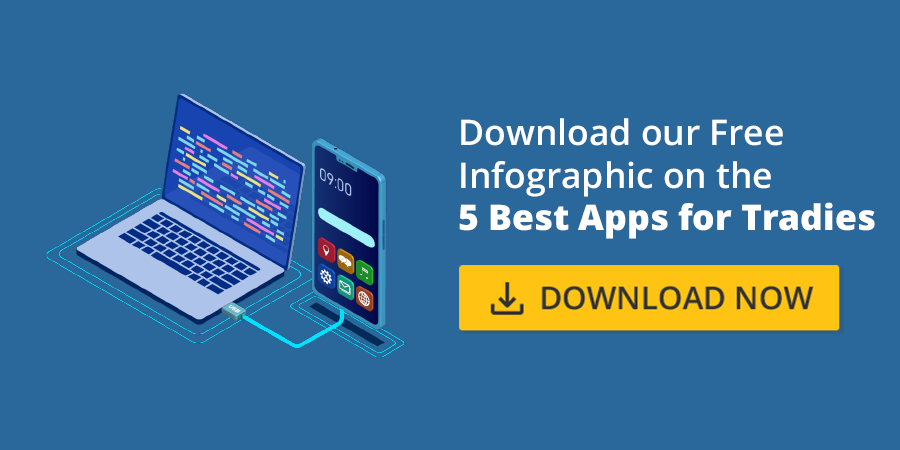Introduction
As with any enterprise, running a tradie business demands a lot from its owners and staff.
There’s simply no end to the number of routine tasks that need doing in order to keep a business operational. Tradies have to manage accounting, capture and process their leads, maintain an accurate schedule, coordinate with their clients (and suppliers, and employees), receive payments and provide excellent and consistent service when all is said and done.
With all these moving parts, the risk of burning out or committing costly mistakes increases significantly. Focus is a finite resource, after all, and so is the patience to manage work-related stress.
Running a business smoothly is a tall order in and of itself, but the job goes from difficult to damn near impossible when you factor in the important element of growth. Nobody wants their business to stagnate, but who has the time to raise the bar while they’re busy drowning in work?
For most tradie business owners, the root of this problem is a matter of optimisation: finding ways to achieve maximum impact with minimal effort.
In today’s business landscape, the only reasonable solution is to automate: to set particular tasks to run on autopilot so that you and your people can spend more time on the work that grows your business.
Fortunately, there are plenty of apps and tools available on the market that make greater efficiency and automation a possibility for tradie businesses of all sizes. We’ll go over everything you need to know about the subject—starting with this article covering the basics.
For a crash course on modernising your business with the latest tradie apps and software, read on.

Part 1: Understanding Tradie Apps and Automation
We’re sure you’re familiar with apps and software—it’s impossible to own a smartphone or a computer without having used at least a good handful of them. In the simplest terms, these are the programs that add functionality to your electronic devices: web browsers, calculators, messaging platforms, and the like.
Tradie apps are programs that are specifically designed to facilitate core business functions that matter to trades businesses. You can think of them as falling into two categories: apps that expedite tasks, and apps that automate them.
Expedite vs Automate
Apps can expedite your employees’ tasks by reducing the amount of manual work and/or brainpower needed to reach a certain goal like balancing your books, managing inventory, or scheduling jobs and appointments.
One notable example of apps that expedite include Fergus, a field service management tool capable of tracking jobs, assigning staff members, and generating invoices. Another good example would be drawing tools like Floorplanner, which makes short work of mapping and planning interior layouts.
Most modern businesses simply cannot function without a little help from digital tools to expedite processes. Think of it as being given a calculator when ordinarily, you’d have to use your fingers to count and compute.
The real magic happens when apps automate your tasks, setting them up to run themselves so your staff can busy themselves with more important matters. Similar to how early industrial machines made it possible to shift from assembly lines to more efficient modes of production, certain apps can free your employees of a range of mundane tasks.
For today’s small and medium tradie businesses, a stellar example of app-based automation would include Xero, which lets owners (or their accountants) upload pricing and inventory information to make quote generation as easy as picking items from a dropdown menu.
If you want to have any hope of scaling your business, figuring out automation is a must. By winning back more time for yourself and your workforce, you can complete more jobs, increase your revenue, and reinvest that money into achieving even greater productivity.
Local vs Cloud-Based Apps
When you think of apps and software, it’s more than likely that your mental image involves downloading a program from the app store or installing something onto your desktop computer.
These locally-hosted programs are downloaded from the internet and installed onto your devices—you’ll need access to a specific phone, tablet, or computer in order to use them. They may or may not need an internet connection in order to function.
Apps like these are only part of the bigger picture, however, as there’s a growing number of programs that can be run from any compatible device using a browser.
Cloud-based programs are available for users to access on-demand via the internet. They don’t usually require you to install anything on your devices, though when they do, you can expect file sizes to be small and installation time to be minimal.
There are upsides and downsides to each model.
Local hosting isn’t reliant on a stable internet connection, so your business won’t shut down if your ISP fails you. It’s also relatively more secure: since associated files will be kept on your devices, there’s less of a threat of losing data to a security breach. This strength is also the model’s weakness: you’ll have to go through a few hoops to transfer files and access your software if your usual device is unavailable.
Cloud-based hosting is significantly more convenient for users who find themselves manning different devices, transferring data to other users, and working on-the-go. The drawback of requiring an internet connection isn’t as big of a problem now that cellular infrastructure has advanced, though spotty reception can prove to be an inconvenience when using cloud apps.
Pricing Schemes
There are many different pricing systems you’ll encounter as you shop for tradie apps. Prices can range greatly depending on the type of app you’re sourcing, but there are general kinds of pricing schemes on the market.
Free apps are rather self-explanatory. These are programs that cost you nothing to install or use. There are plenty of free applications that can save you time and effort, though their primary drawback comes from the fact that their developers aren’t obligated to treat you like a customer.
Don’t expect much in the way of user support or troubleshooting, and be prepared to turn to online instructionals to learn how to make the most out of any free apps you wind up choosing.
Subscription-based apps (sometimes called “software as a service”, or SaaS for short) charge a periodic rate—usually a monthly fee or annual payment, with the latter frequently being discounted.
Since subscription providers have an interest in retaining their clients, they’re more likely than not to make sure that users are well-supported. Expect instructional tools like videos or training calls, as well as access to on-demand support staff.
Apps and software that charge a one-time fee are paid for like any generic product: spend once, and the tools are yours for life.
Customer support may be available, especially when the tools come from active and reputable developers, but note that subscription-based apps tend to be more keen on providing support.
Part 2: The Different Types of Tradie Apps
There’s an app for pretty much everything nowadays, and the various tradie tasks are no exception. In this section, we’ll be breaking down the different ways your applications can make life easier for you while on the job.
Take note that you might see a few notable features recur as the list goes on. While apps do break apart into specialised categories, some developers aim to create one-stop shops (so to speak) for tradies looking to go digital. For example, automatic quote generation can be found in most quoting apps and some accounting apps.
Job Quoting Apps
When it comes to your sales flow, the earlier steps are critical. Today’s customers have learned to expect speed and convenience when sourcing their products and services. To delight your clients from the point of first contact, it pays to be able to hand out quotes as quickly and accurately as possible.

Job quoting apps are programs built to help tradies (or any service providers, really) create price estimates with as little pain as possible. Instead of manually calculating each and every inquiry that gets sent your way, these tools allow you to compose estimates using a pre-set list of rates per quantity of material, or per hour of skilled labour.
Mathematical tasks like quoting are prime candidates for app-based assistance, since there are plenty of ways that manual calculation could go wrong. We highly recommend working a quality app into your workflow sooner rather than later.
The best job quoting apps come plenty of functions, but the following are must-haves:
- Set custom rates for labour and materials
- Automate your quoting and billing
- Import and organise your financial documents
- Allow clients to engage with your quotes in real-time
For a deeper look into job quoting apps, read our article on the subject.
Job Booking Apps
After your clients have reviewed their quotes, the usual next step is to either get into a phone call, or have a face-to-face meeting with one of your representatives. Either of these two most-likely cases takes time and energy for all parties involved—time that could be cut down to mere moments with the help of the right booking tool.
The booking process is one of the easiest to automate because it drills down to a predictable workflow:
Step One
A client reaches out to Tradie.
Step Two
Client explains the job that needs doing.
Step Three
Client and Tradie schedule an assessment (when needed).
Step Four
Client and Tradie agree on terms.
Step Five
Tradie performs the job.
Step Six
Everybody’s happy.
Most tradies lean on digital tools for Step One, collecting leads through their website and handling the rest through calls and meetings. It might surprise you to know that the right software can expedite the process all the way through to Step Four.
Smarter web pages and contact forms allow tradies to collect all vital job information, automatically dispense quotations, and set their calendars with minimal human involvement. The right ecosystem should see you receive notifications about new job orders without having to lift a finger.
For a deeper look into job booking apps, read our article on the subject.
Job Management Apps
Even the simplest tradie jobs come with a lot of moving parts. Your average tradie boss has to keep a handle on a multitude of tasks, and it’s nigh impossible to pay attention to everything that matters without a good system.
A proper job management app gives you a real-time, bird’s eye view of your operation. Think of it as a virtual control room that lets you run your shop from a single device—eliminating the need to flip through journal entries, search for phone numbers, and cram notes into the margins of a calendar.
There are plenty of features you could look for in a job management app. Here are a few of the top considerations:
- Communication. A management app should let you keep in touch with your clients, your suppliers, and your employees on the ground. Communication can be as involved as a messaging app, or as explicit as the option to share files and see live updates in real-time.
- Task Delegation. Ideally, your job management app should allow you to create profiles for each of your tradies and match them to corresponding tasks. A clear division of labour is key, so look for apps that allow you to keep your staff and their assignments organised.
- Inventory Tracking. It’s easy to lose track of inventory and run out of critical items—especially when business is doing well and work is plenty. Some job management apps double as inventory management systems, allowing you to adjust and monitor your stock levels in real-time.
- Record Keeping. We’ve heard too many stories of tradies landing themselves in a spot of trouble because of missing documents. One welcome feature you might find in a job management app is document storage and organisation.
For a deeper look into job management apps, read our article on the subject.
Or check out our article dedicated to construction management software.

Accounting Software
The set of accounting tasks is perfect for a digital upgrade. Spreadsheets are limited by their need for setup and their inability to integrate with record keeping—we recommend finding an app post-haste.
Work closely with your accountant when sifting through the market for accounting apps and software. Each business may need something specific out of their apps’ functionality, so a little diligence when sourcing your app can go a long way.
As always, we highly recommend checking out Xero. If you’ve followed our work here at Tradiematepro, then you know we’re all for their cloud-based invoicing, digital banking integrations, inventory tracking, and payroll features.
For a deeper look into accounting software, read our article on the subject.
Floor Plan Drafting Software
Now that we’re well into 2019, we sincerely hope that our readers who are in the business of construction or remodeling have stopped drawing floor plans by hand. There are any number of apps that can do a quicker, more accurate job ranging from free-to-use tools to enterprise-grade software.
A good drafting software is a must-have for any business that needs to create or alter floor plans. They allow for smoother communications and expectation-setting with clients, offer the greatest possible degrees of accuracy and precision, and give you the exact numbers you need to better estimate your final costs.
The nature of the editing interface itself may vary, but you should definitely experiment to find the app that can provide you with smooth integration into your current workflows.
For a deeper look into floor plan drawing software, read our article on the subject.

Part 3: How to Find the Best Apps for Your Tradie Business
Putting together a set of apps that fit your business perfectly is no small feat. It’s a weighty decision, similar to adopting new tools of the trade: the right selection makes for improved customer service, while the wrong selection can be costly to undo.
Since there’s no such thing as one-size-fits-all, it’s worth going over the reasoning that should govern your selection process. In this section, we’ll talk about the steps you ought to take when finding the best apps for your tradie business.
Assess Your Needs
The market for apps related to business and productivity is huge (as of this writing, there are an estimated 10,000+ different SaaS vendors globally), so it’s easy to get confused if you don’t go in with a plan.
Conduct a detailed assessment of your business’ needs and pain points. These involve any potential gaps in your expertise (we don’t quite know enough about X), bottlenecks in your workflow (it’s a routine struggle having to deal with Y), and tasks that you feel take up more time than they’re worth (we need to spend less time on Z).
These points of friction slow your operations down, and often trace back to a manual status quo. For example, a few minutes a day spent calendaring will add up over time, and provide a regular source of disruption for your focus.
Likewise, it pays to note that many time-wasting activities can go unnoticed because of how often they need doing. Take a step back and revisit what’s been said about time management: you’ll find that there’s an important distinction between work that grows your business and work that simply keeps the lights on.
We recommend classifying the time you and your tradies spend on the job into growth and maintenance. Growth tasks are centred on developing new strategies and processes to improve your business, whereas maintenance tasks are concerned with deploying the strategies and processes you have.
Remember that neither task is more important than the other—you need to innovate to scale and compete, but you can’t do that if you’re losing good business.

Imagine What Your Perfect Suite of Tools Would Resemble
After you’ve identified the tasks that are slowing you down, the next step is to figure out how digital tools could help you go about simplifying them.
In a perfect world, how would you go about making your tasks easier? What work would you pass on to an intern (assuming cost wasn’t an issue)?
Get a clear mental picture of an imaginary piece of software could reduce the amount of effort that goes into your maintenance tasks, and assist you in developing newer, better ways of capturing leads and doing business.
Google it
This third step is intuitive: scour the internet for examples of leading tools.
Use broad terms related to the specific problems and solutions you’ve discovered through the last two steps, and take note of options that stand out. Your early findings should spark new ideas for finer and more precise terms to use for a second round of searching.
Although we’re conditioned to believe that top results carry more authority, know that the first listings you see aren’t guaranteed to be the best fit for you. Be diligent when turning to Google for your options!
Source Reviews and Recommendations
Referrals and testimonials from actual users are invaluable tools when narrowing down your options for a new investment in software.
The best way to get accurate and unbiased reviews is to reach out to any contacts you might have who’ve had experience in the industry. Whether they’re a mentor, related business, or even a friendly competitor, they’re bound to have insights into apps that have or haven’t worked for them in the past.
Check out groups like The Site Shed on Facebook to see what your peers in the trades industry have to say about the apps you’re considering, and pay attention to the reviews you encounter while vetting. CNet and similar online forums can also be very useful when considering tradie apps (or any software, for that matter).
Finally, you want to take advantage of any free trials that your top candidates offer. You can make better comparisons (and later, better decisions) when you’ve had hands-on experience with tools.
Part 4: Working New Apps into Your Business Model
No matter how intuitive an app might be, there’ll always be a learning curve associated with adopting new technology. Since your tools are only as good as how you use them, we’re dedicating this section to the best ways to work new apps into your business model.
Note that these steps can be followed while you’re working through free trial periods for your most promising apps. You shouldn’t have to wait until you’ve already paid to practice working with new tech.
Steps to work new apps into your business model
- Update your workflows
- Update your training
- Monitor deployment
- Optimise
1. Update your workflows
The whole point of investing in more efficient tools is to be able to make smart changes to your workflows. Naturally, this means disrupting the status quo—which can be a problem if your business doesn’t take a strategic approach to deal with innovation.
Work with your staff members to examine your current processes, and map out the different improvements that your new apps will bring about. We recommend breaking each job down into steps—from the moment a client first reaches out to you, to your final post-assessment—and isolating tasks that’ll change once your new tools are deployed.
If you keep an employee manual or a similar document that covers your protocols, don’t forget to give it an update. In a similar vein, you could invest a little time in printing user manuals or creating cheat-sheets for your new apps and software.
Taking a clear picture of your operational status quo means you won’t run into any surprises down the line, and that your integration efforts are well-informed.
2. Update your training
Training is the heart and soul of your capacity to serve, and you have to make sure that each of your tradies are equipped to handle the apps or software you’ll be using in the service of your clients.
We highly recommend including software training into your onboarding process, and taking the time to reorient your existing staff members. The new workflows you’ve identified from the previous step will come in handy: you know what tasks need doing, so make sure to cover how they’re done.
Your training manuals and/or guidelines should also change to reflect the tools you’ve decided to keep.
We urge all tradie bosses to familiarise themselves with the work expected of their employees, and understanding new tools is an extension of this. Get to know the software you’re paying for: it keeps you grounded in the nature of your own business, and helps you remain an important asset to your staff.
3. Monitor deployment
Don’t make the mistake of thinking that investing in a feature-packed and professional set of apps and computer programs will fix all your problems for you. Deployment matters, and plenty of hiccups, delays, and unforeseen bottlenecks can and will likely emerge as you implement your new solutions.
Set up regular meetings with your managers and staff to check in on how well they’re adapting to the changes to their working environments. Encourage your tradies to share their thoughts, frustrations, and observations about their time working with new tools, so you can act quickly to smooth out any problems that might come up.
You may opt to ask your managers or senior tradies to draft reports about the integration process. Be sure to include valuable questions like:
- How difficult is it to learn the app?
- How difficult is it to use the app?
- How has the app affected your time to completion?
- How has the app affected your volume of accomplished tasks?
- What other features would you want to see from your app?
With the above being said, it’s important to distinguish when an app simply doesn’t make the cut. Not all apps are worth the effort to master, and knowing the difference between a tough learning curve and poorly designed software can save you time and money.
We believe that the most important factor that goes into evaluating an app’s worth is something we call the Stress Test. We don’t mean subjecting your tools to the worst possible conditions—we mean minding how much stress goes into getting them to work for you after you’ve breached the learning curve.
Once you understand how everything works, it’s important to pay attention to how the work feels.
The best apps relieve stress by being intuitive and convenient. All the most important buttons and functions should be within easy reach, and after you’ve learned how to use them, they reward you by giving you a simple path from, “Let’s start,” to, “All finished.”
Conversely, terrible apps don’t get any easier to use even after you’ve learned everything you have to about their use. They’re cluttered, difficult to navigate, and slow you down worse than if you’d gone ahead and done the job manually.
If your experience remains stressful even after studying the tool, then take it as a sign that you might do better looking elsewhere.
4. Optimise
The observations you make and reports you collect can and should be used to pursue concrete improvements over time.
You can use your findings to fine-tune your training regimens, identify key support roles for later rounds of hiring, and ultimately decide whether or not the software you’re working with is indeed a good fit for your business.
We don’t recommend giving up on apps the minute you encounter a problem. If there are functions you can’t seem to get right, reach out to your apps’ developers or customer support staff (when applicable) and see if they can’t help you arrive at a fix.
Some apps come with deceptive learning curves, but that’s the nature of technology: it takes an investment of time to make the most out of your investments in tech.
Conclusion
It’s important that your business get into the habit of working with apps and automation, if you want to have any hope of expanding your productivity and keeping up with the rising tide of smarter businesses.
We’ve gone over their defining characteristics, the different types of apps you might encounter, steps towards finding the ones best suited for you, and the processes that lead to better integration.
Moving forward, we urge you to get started and take a good, long look at the bottlenecks and redundancies that distract you and your tradies from taking your business to new heights. After all, a thorough self-examination goes a long way towards perfecting your app ecosystem.
As always, our lines are open for any questions and concerns you might have relating to apps, automation, or all things relating to tradie work. Drop us a message or give us a call, and we’ll pair you up with one of our seasoned, in-house experts.







